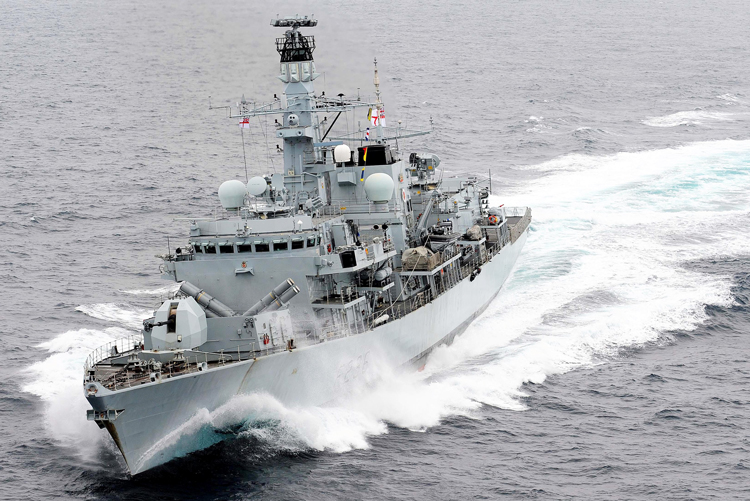The capitalist rulers in Washington and their imperialist allies continue to make threats against Tehran and stoke military tensions in the Gulf. The U.S. government has sent a naval armada into the Red Sea, a B-52 bomber squadron and 1,000 additional troops, using the pretext of a series of attacks on ships there that Washington blames on Tehran.
The U.S. rulers have stepped up punishing sanctions aimed at forcing the Iranian government into talks to stop it from developing nuclear weapons and to constrain Tehran’s political and military reach in the Middle East.
The HMS Montrose, a British warship, drove off three Iranian vessels that London says were trying to block the passage of the British Heritage, an oil tanker sailing in the Strait of Hormuz July 10. U.S. aircraft monitored the confrontation. The Heritage was in waters that are disputed by the governments of Iran and the United Arab Emirates, according to the Daily Telegraph.
The encounter comes days after British Royal Marines stormed and seized the Grace 1, a tanker carrying oil from Iran, in an act of piracy near the British colony of Gibraltar. A commander in Iran’s Revolutionary Guard threatened to seize a British ship in retaliation. London has since released the ship’s crew, but still holds the captured vessel, saying it will not release it unless the Iranian government promises not to transport the oil to Syria, which London and other European powers have sanctioned.
A number of British-flagged vessels in the Gulf now sail with naval escorts. Some 20% of all the world’s oil trade passes through the Strait of Hormuz.
Washington, which deploys 21 warships in the Gulf, is seeking to establish a naval coalition to escort commercial vessels around the coast of Iran and Yemen up to the Red Sea, in the name of upholding “freedom of navigation.” So far the plan has received backing from the governments of Saudi Arabia and the UAE.
Towards the end of the Iraq-Iran war in the late 1980s, the U.S. government, which was providing support to Saddam Hussein’s regime in Baghdad, sent warships to escort tankers through the Gulf, engaged in battles with the Iranian navy and accidentally shot down an Iranian commercial aircraft in 1988, killing 290 people. Then President Ronald Reagan sent an apology to Tehran, saying the U.S. forces mistakenly believed the plane was an Iranian fighter jet.
Washington on July 10 threatened to “substantially” increase the sanctions it foists on Iran. The punitive measures the U.S. rulers already impose with bipartisan support have deepened the economic misery bearing down on working people there.
While neither the U.S. nor Iranian rulers are seeking all-out war, the escalating tensions, U.S. deployments and mutual threats are dangerous.
“The U.S. government says ‘we’ are threatened by Iran. But the class interests of working people and of the wealthy capitalists are not the same. Working people need our own foreign policy, independent of the bosses’ parties, based on the common interests we share with other workers around the world,” Seth Galinsky, Socialist Workers Party candidate for New York City public advocate, said July 13. “My campaign demands the U.S. government immediately end its sanctions on Iran and unconditionally withdraw its military forces from the Middle East.”
Moscow’s bombing devastates Syria
Washington has stepped up its sanctions on Iran to press the rulers there to dismantle military bases Tehran has established through intervention in the wars in Iraq and Syria, halt its backing for Hezbollah in Lebanon and pull back from the support it provides to Houthi forces fighting in Yemen’s civil war.
Militias organized by Tehran and ally Hezbollah, coupled with air power from Moscow, have provided the military clout to prop up the dictatorial Bashar al-Assad regime in Syria.
A popular uprising by the toilers demanding political rights and an end to government repression swept Syria in 2011. No revolutionary working-class leadership existed that was capable of leading this struggle and resolving the conflict in the interests of the toiling majority. In this political vacuum, bourgeois Islamist forces, which included the Islamic State, were able to seize parts of the country.
Today IS has been destroyed, and many of the other Islamist groups, who are backed by the Recep Tayyip Erdogan government in Turkey, have been pushed into Idlib province. Moscow has led ferocious airstrikes on the population of 3 million there since late April. Some 330,000 people have fled toward the Turkish border and hundreds have been killed. Still, Assad has been unable to retake any part of the province.
Kurdish forces control a wide swath of northeastern Syria, where an autonomous Kurdish region has been established. The Kurdish-led Syrian Democratic Forces took control of the area, which contains the majority of Syria’s oil fields, after defeating Islamic State.
Some 30 million Kurdish people are divided across Iraq, Iran, Syria and Turkey and have fought for their national rights — denied by the capitalist rulers in those countries — for decades. Washington maintains bases in the SDF-held part of Syria, part of its efforts to counter the influence of Tehran and Moscow.
Syrian Democratic Forces depends in part on revenue from sales of oil to the Assad government, which faces increasing fuel shortages as a result of Washington’s sanctions on Iran.


